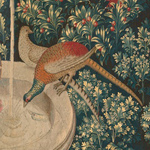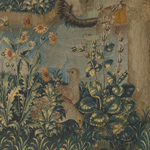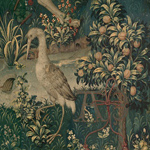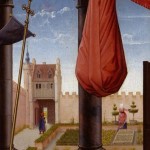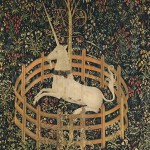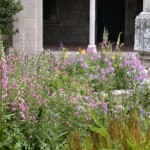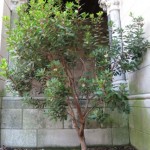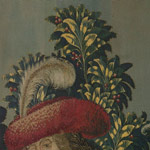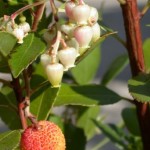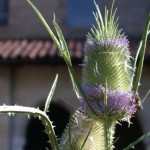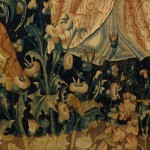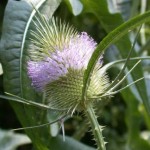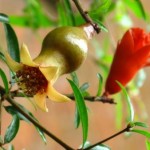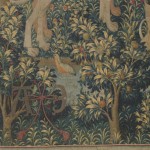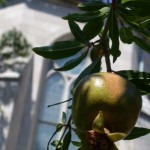Archive for the ‘Plants in Medieval Art’ Category
Thursday, February 11, 2010
Above, from left to right: In The Unicorn is Found, a handsome pair of pheasants has been attracted to the fountain (the larger detail shows two goldfinches and a nightingale perched nearby); two partridges keep company on the bank at the bottom of The Unicorn is Attacked; The Unicorn Defends Itself includes a stately heron, and a woodcock and a mallard flying low to the water are visible in the larger detail.
Saynt Valentyn, that art ful hy on-lofte,
Thus syngen smale foules for thy sake:
Now welcome, somer, with thy sonne softe,
That hast this wintres wedres overshake.
Wel han they cause for to gladen ofte,
Sith ech of hem recovered hath hys make;
Ful blissful mowe they synge when they wake:
Now welcome, somer, with thy sonne softe
That hast this wintres wedres overshake
And driven away the longe nyghtes blake!
???Excerpt (lines 682???692) from The Parlement of Fowles by Geoffrey Chaucer. For a modern prose translation of the complete work, see: www.umm.maine.edu/faculty/necastro/chaucer/pf/.
Read more »
Tags: Chaucer, goldfinch, heron, mallard, partridge, Paston, pheasant, Robert Herrick, Saint Valentine, sparrow, Unicorn tapestries, woodcock
Posted in Plants in Medieval Art, The Medieval Calendar | Comments (3)
Friday, February 5, 2010
Above, from left to right: Detail from The Annunciation (17.190.7); Detail from The Unicorn in Captivity (37.80.6); Trie Cloister Garden in bloom.
???fruit trees that grow easily, such as cherries and apples, should be planted in place of walls; or, what is better, willows or elms or birch trees should be planted there, and their growth should be controlled for several years, both by grafting and by stakes, poles, and ties, so that walls and a roof might be formed from them.
???Book III: “On the Gardens of Kings and other Illustrious Lords.” Piero de’ Crescenzi, Liber ruralium commodorum (1305-09). (See Catena, the Bard Graduate Center’s Digital Archive of Historic Gardens and Landscapes for more information.)
In my undergraduate studies in landscape and architecture, I examined how the natural landscape is used to determine designs for parks, gardens, and public spaces. I took part in several design processes, which included research on site analysis, interviewing potential patrons of public spaces, building models of future designs, and using plants to blend artistic design with nature. I learned to look at the land as a palimpsest rather than a blank slate, and to examine its many layers of use throughout history, understanding that context is an important influence on new designs. Now, as the new assistant horticulturist here at The Cloisters, I’ve found more levels of meaning to my studies, and am inspired to think about design issues from a landscape historian’s perspective. Read more »
Tags: architecture, chastity, design, landscape, park, Piero de' Crescenzi, pomegranate, Punica granatum, Unicorn in Captivity, Unicorn tapestries, Virgin
Posted in Gardening at The Cloisters, Plants in Medieval Art | Comments (4)
Friday, December 11, 2009
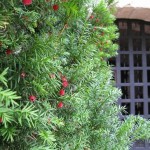
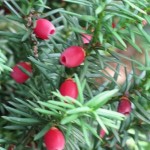
Above, from left to right: A large yew tree (Taxus baccata) growing near the portcullis on the lower drive of The Cloisters; a detail of the yew in fruit in mid-November. The gelatinous red flesh surrounding the seeds is as sweet as it looks, and is innocuous, but the seed itself is very toxic, as are the leaves.
There is here above the brotherhood
A bright tall glossy yew;
The melodious bell sends out a keen clear note
In St. Columba???s church.
???Fragment of an Irish poem, ca. 800???1000
Read more »
Tags: Beowulf, Girolamo dai Libri, Taxus_baccata, tree_of_death, tree_of_life, yew
Posted in Magical Plants, Plants in Medieval Art, Useful Plants | Comments (4)
Wednesday, November 4, 2009
Above, from left: A strawberry tree growing in a sheltered corner in Trie garden; Arbutus unedo in fruit in the woodland of The Unicorn At Bay; the evergreen strawberry tree bears flowers and fruit simultaneously in late October.
A native of the Mediterranean, the strawberry tree (Arbutus unedo) is valued as an ornamental evergreen whose late-blooming flowers and red fruits enliven the garden in late fall and early winter, when few other species are of interest. The common name derives from the description of the tree made by Pliny the Elder, who compares the fruit, with its thin, rough, red rind, to that of the strawberry, Fragaria vesca. Read more »
Tags: Arbutus unedo, strawberry tree
Posted in Food and Beverage Plants, Gardening at The Cloisters, Medicinal Plants, Plants in Medieval Art | Comments (0)
Friday, October 23, 2009
Above, from left: The medicinal teasel, Dipsacus fullonum, growing in Bonnefont garden; a teasel depicted in the foreground of The Hunt of the Frail Stag: Vanity Sounds the Horn, and Ignorance Unleashes the Hounds Overconfidence, Rashness, and Desire, South Netherlandish, about 1500???1525, Wool and silk, The Metropolitan Museum of Art, New York, Bequest of Mary Stillman Harkness, 1950 (50.145.4); detail of the flower head, whose straight spines distinguish this species from D. sativus.
The principal medieval uses of the wild teasel, Dipsacus fullonum, were medicinal. (See last week’s post for uses of the cultivated form.) Read more »
Tags: Dipsacus_fullonum, teasel
Posted in Magical Plants, Medicinal Plants, Plants in Medieval Art | Comments (8)
Friday, July 31, 2009
Above, from left to right: A potted dwarf pomegranate flowering and fruiting now; a detail of a pomegranate tree depicted in The Unicorn Is Attacked; a full-sized pomegranate ripening on a tree set in the ground in Bonnefont Garden. Pomegranates are deciduous; the leaves turn a bright yellow before falling in October. By the Middle Ages, the exotic??eastern fruit had long been cultivated in southern Europe. Although it is not cold-hardy,??pomegranate has been grown in the gardens of The Cloisters from their beginnings.
I went down into the nut orchard,
to look at the blossoms of the
valley,
To see whether the vines had budded,
whether the pomegranates were
in bloom.
Before I was aware, my fancy set me
in a chariot beside my prince.
???Song of Solomon 6:11 and 12 (Revised Standard Version)
Read more »
Tags: antioxidant, fertility, fruit, pomegranate, Punica granatum, Unicorn tapestries
Posted in Food and Beverage Plants, Medicinal Plants, Plants in Medieval Art | Comments (8)
Friday, May 15, 2009
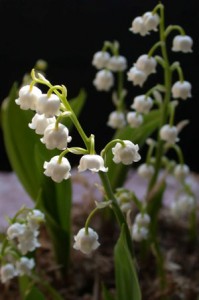
Above: Lily of the valley (Convallaria majalis)
White coral bells upon a slender stalk
Lilies-of-the-valley deck my garden walk. . . .
???Traditional English Round
In spite of its medieval association with the exotic Queen of Sheba (see last week’s post), this modest, northern European woodland flower is actually as easy to grow as it is familiar. Read more »
Tags: Convallaria majalis, lily of the valley
Posted in Botany for Gardeners, Fragrant Plants, Gardening at The Cloisters, Medicinal Plants, Plants in Medieval Art | Comments (7)
Friday, May 8, 2009
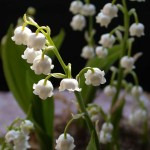
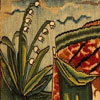
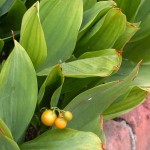
Above, from left to right: Detail of a potted lily of the valley forced for early display in Cuxa cloister; Detail of the tapestry The Queen of Sheba before King Solomon from Two Riddles of the Queen of Sheba; Lily of the valley fruiting in Bonnefont Garden in late summer.
I am the flower of the field,
And the lily of the valleys.
As the lily among thorns, so is
My love among the daughters.
???Canticle of Canticles (Song of Songs) 2:1-2
The lily and the rose are the chief adornments of the allegorical hortus conclusus, the enclosed garden of the Virgin rooted in the language of the Song of Songs in the Old Testament. Read more »
Tags: Convallaria majalis, lily of the valley, May, Solomon and Sheba, Song of Songs, Virgin
Posted in Gardening at The Cloisters, Medicinal Plants, Plants in Medieval Art | Comments (2)
Friday, February 27, 2009
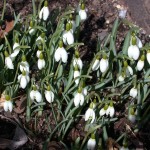
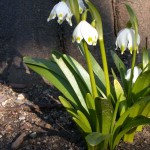
Left:??The snowdrops (Galanthus nivalis) under the quince trees in Bonnefont Cloister bloom from February to March, while snowdrops in warmer climates may flower as early as January; right: the closely related spring snowflake (Leucojum vernum) blooms from March to May.
The winter-blooming snowdrop and spring snowflake appear so closely related that the great sixteenth-century herbalist John Gerard named them the Early Blooming Bulbous Violet and the Late Blooming Bulbous Violet. Read more »
Tags: Galanthus, Leucojum, Mary plant, snowdrop, snowflake
Posted in Fragrant Plants, Gardening at The Cloisters, Plants in Medieval Art | Comments (2)
Friday, January 16, 2009
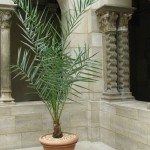

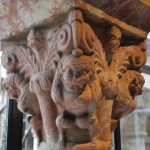
Above, from left to right: young date palm growing in a pot in Saint-Guilhem Cloister; a juvenile date palm represented in the northern European landscape of The Start of the Hunt; a date palm flanked by lions in a column capital in Cuxa Cloister.
A plant of ancient cultivation, grown for some five thousand years and with an equally long presence in art and architecture, the date palm (Phoenix dactylifera) was and is both economically and symbolically important. Date palms have provided an important food, an intoxicating liquor, a sweetener, and a building material. Identified in the ancient Near East with the Tree of Life, the palm has both religious and artistic significance in Jewish, Islamic, and Christian tradition as a symbol of grace, elegance, victory, wealth, and fecundity and is frequently associated with Paradise in medieval and Renaissance art and literature. There are forty-two Biblical references to the date palm (Moldenke and Moldenke, Plants of the Bible, 1952). An emblem of victory in Greco-Roman tradition, the palm was adopted as one of the earliest and most important plant symbols in the Christian Church, and was an emblem of the martyred saints in their victory over sin and death. Read more »
Tags: date palm, Phoenix dactylifera
Posted in Food and Beverage Plants, Plants in Medieval Art | Comments (0)
